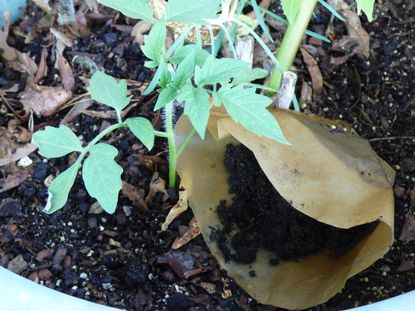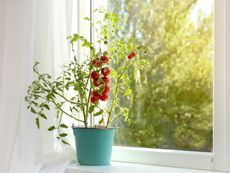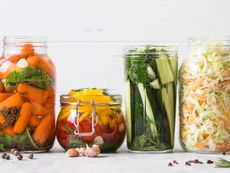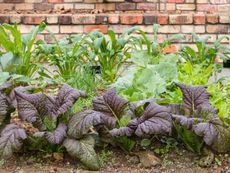Can You Grow Vegetables In Coffee Grounds: Using Coffee Grounds In Your Vegetable Garden


For a diehard coffee drinker like me, a cup of Joe is a necessity in the morning. As I am a gardener, I’ve heard tales about using coffee grounds in your vegetable garden. Is this a myth, or can you grow vegetables in coffee grounds? Read on to find out if coffee grounds are good for vegetables, and if so, all about growing veggies in coffee grounds.
Can You Grow Vegetables in Coffee Grounds?
It’s true fellow coffeeholics! You can use coffee grounds for vegetables. Our morning elixir is not only a morning perk but can be beneficial to our gardens too. So how are coffee grounds good for vegetables? I’m sure many of us consider coffee to be acidic but that is actually a fallacy. The grounds are not all that acidic; in fact, they are close to pH neutral-- between 6.5 and 6.8. How can this be, you ask? The acidity in coffee is restricted to the brew itself. Once water passes through the grounds when percolating, it essentially flushes most of the acid out. Coffee grounds also contain 2 percent nitrogen by volume but that doesn’t mean they can replace a nitrogen rich fertilizer. So how do you use coffee grounds for vegetables?
Growing Veggies in Coffee Grounds
Too much of anything can careen onto negative ground. This is true of using coffee grounds in your vegetable garden. To use the grounds in your garden, incorporate about 1 inch (2.5 cm.) (up to 35 percent grounds to soil ratio) directly into the soil or spread the grounds directly onto the soil and cover with leaves, compost, or bark mulch. Till the coffee grounds into the soil to a depth of between 6 and 8 inches (15-20 cm.). What will this do for the veggie garden? It will improve the availability of copper, magnesium, potassium, and phosphorus. Also, each cubic yard (765 l.) of grounds affords 10 pounds (4.5 kg.) of slowly released nitrogen to be available to the plants over a long time period. Additionally, the nearly infinitesimal acidity may benefit alkaline soils, as well as acid loving plants like camellias and azaleas. All in all, coffee grounds are good for vegetables and other plants, as they encourage the growth of microorganisms in the soil and improve tilth.
Other Uses for Coffee Grounds in the Garden
Coffee grounds aren’t just for growing vegetables, they make a great addition to the compost or worm bins. In the compost pile, layer one-third leaves, one-third grass clippings, and one-third coffee grounds. Throw in the coffee filters too as an added carbon source. Tear them up first to hasten decomposition. Don’t add more than 15 to 20 percent of the total compost volume or the compost pile may not heat up enough to decompose. It may take three months or longer for it to completely decompose. Worms apparently have a weakness for coffee as well. Again, too much of a good thing can turn against you, so add just a cup or so of the grounds each week or every other week. Use coffee grounds as a snail and slug barrier. The grounds are abrasive much like diatomaceous earth. Make a coffee ground infusion to use as a liquid fertilizer or foliar feed. Add 2 cups (.47 L.) of coffee grounds to a 5 gallon (19 L.) bucket of water and let it steep for a few hours to overnight. If you are an avid coffee consumer and/or you are getting large quantities of grounds from a local coffee shop, store them in a plastic trash bin until you can use them.
Gardening tips, videos, info and more delivered right to your inbox!
Sign up for the Gardening Know How newsletter today and receive a free download of our most popular eBook "How to Grow Delicious Tomatoes."

Amy Grant has been gardening for 30 years and writing for 15. A professional chef and caterer, Amy's area of expertise is culinary gardening.
-
 Urban Composting Guide: How To Compost In The Middle Of The City
Urban Composting Guide: How To Compost In The Middle Of The CityUrban composting does not have to be daunting. You can compost in the city, and maybe even try some urban worm composting!
By Mary Ellen Ellis
-
 Shrub Diseases And Pests To Watch Out For
Shrub Diseases And Pests To Watch Out ForShrub diseases and pests can be challenging. Learn how to recognize and eradicate them before they can present a danger to your plants.
By Susan Albert
-
 How Many Vegetables To Plant Per Person For A Year
How Many Vegetables To Plant Per Person For A YearGauging how much to plant in a vegetable garden can eliminate waste while still producing enough for your family. Click for more.
By Bonnie L. Grant
-
 13 Perennial Fruits And Vegetables You Only Have To Plant Once
13 Perennial Fruits And Vegetables You Only Have To Plant OnceLooking to set it and forget it? Find out which fruits and vegetables can be grown as perennials.
By Laura Miller
-
 11 Edible Plants For A Year-Round Garden In A Bucket
11 Edible Plants For A Year-Round Garden In A BucketWant to know how to grow food inside your house and which foods do best indoors? Click here to learn all about it.
By Bonnie L. Grant
-
 Frost Tolerance Of Vegetables From Least To Most Hardy
Frost Tolerance Of Vegetables From Least To Most HardyHow cold can vegetables tolerate? Knowing which veggies will survive frosts and freezes is essential for the success of your garden. Click here for more.
By Laura Miller
-
 Best Vegetables To Pickle Straight From The Garden
Best Vegetables To Pickle Straight From The GardenPickles aren’t limited to just cucumbers. Read on for tips on pickling your fresh veggies.
By Amy Grant
-
 Benefits Of Planting In Fall Vs. Spring Vegetable Plots
Benefits Of Planting In Fall Vs. Spring Vegetable PlotsLearn why some vegetables do better if you plant them in fall instead of spring.
By Laura Miller
-
 Interplanting Vegetables In The Fall Garden
Interplanting Vegetables In The Fall GardenLearn all about the benefits of interplanting vegetables for your fall garden.
By Laura Miller
-
 Best Vegetables For Growing In Perlite
Best Vegetables For Growing In PerlitePerlite is a natural growing medium that comes from super-heated volcanic glass. In some cases, it works better than soil. Read on for more info.
By Laura Miller